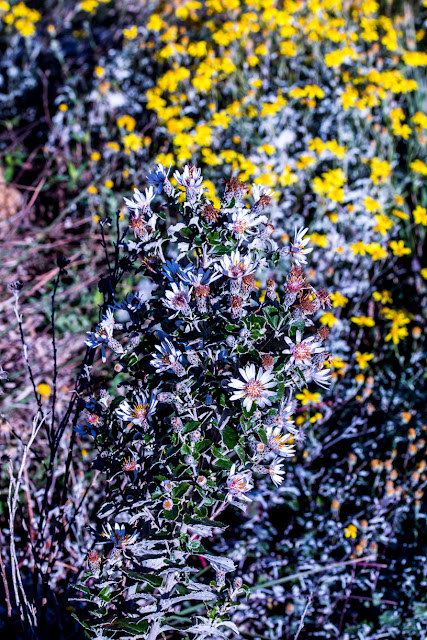Anne, with a semi-healed leg, returned for this walk along with Sally Booker who joined us for the second time. As Anne would not be able to walk far we decided to visit Manilkara Meander so she could leave when her leg had had enough. This suited several others who also wanted to leave early.
When we arrived and parked we immediately noticed a robust bugweed, Solanum mauritianum and as this was too big to uproot, Anne took out a bush knife and Phakamani made short work of cutting it off at the roots. He then also dealt with a fairly large clump of Lantana camara. Both of these invasive aliens will need to be herbicided to prevent regrowth but at least they have been prevented from seeding this season.
Also in this clump we found a small cluster of Priva cordifolia in flower.
 |
| Phakamani hacking at a clump of Lantana camara |
 |
| Priva cordifolia |
We walked across to the forest edge. Here we noticed for the first time a medium sized Atalaya natalensis. We have previously only seen this species in the nearby Smedmore forest so it was good to see another locality, albeit in the same contiguous forest patch. Under the Atalaya was Pilogyne scabra creeper with its minute white flowers and a short distance away we found Erythroxylum pictum flowering. Another find amongst the plants growing on what appeared to be an old termite mound was a cluster of male Stangeria eriopus. This developed into a discussion as we found out from Phakamani about the amaPondo cultural use of this plant which is planted around cattle kraals to promote fertility in the herd.
 |
| Pilogyne scabra |
 |
| Erythroxylum pictum |
Deeper into the forest was a small Eugenia erythrophylla putting out some new leaves - these red coloured and softly hairy leaves are a useful character to identify the species, as are the rolled-under leaf margins. Some metres away was another Eugenia erythrophylla out in the open and also sporting new leaves. On the forest edge there were Cryptocarya wyliei in fruit.
 |
| Eugenia erythrophylla |
 |
| Eugenia erythrophylla |
 |
| Cryptocarya wyliei |
A bit further along the edge we saw small Homalium rufescens putting out sprays of white flowers. On the rock plates below were splashes of colour from Crassula sarmentosa and Crassula obovata and amongst these was Commelina erecta.
 |
| Homalium rufescens |
 |
| Crassula sarmentosa var sarmentosa |
 |
| Crassula obovata var obovata |
 |
| Commelina erecta |
While some of us made our way into the forest edge, others stayed outside only to be terrorised by a puffadder. Also hiding in the grass here was a very well-camouflaged Red tailed moth. Inside the forest we found Plectranthus madagascariensis with tall flower spikes and a small shrub with greeny-yellow flowers that we identified as Maytenus acuminata. At the edge of this piece of forest was Colpoon compressum with flowers and fruits.
 |
| Leaf-like Red tailed moth |
 |
| Plectranthus madagascariensis |
 |
| Maytenus acuminata |
 |
| Colpoon compressum |
At this stage Anne turned back taking several members of the party with her as they also needed to get back for other commitments. The rest of us pressed on. A yellow-flowered Acridocarpus natalitius caught the eye and we saw Buchnera dura peeking out over the grass. There was a Thunbergia dregeana climbing into a shrub and the Loxostylis alata had a profuse show of their red bract-covered fruits.
 |
| Acridocarpus natalitius |
 |
| Buchnera dura |
 |
| Loxostylis alata fruits |
 |
| Thunbergia dregeana |
We stopped for lunch in a sheltered spot, noting a cluster of Liparis remota with fruits in the leaf litter at the edge of the forest. Moving on brought us to a dry water course where we found Euclea natalensis in fruit growing below Strychnos gerrardii that also had small fruits scattered along the branches. At the edge of a rock outcrop Diopspyros scabrida was starting to flower and nearby we found Grewia pondoensis with a single flower open.
 |
| Euclea natalensis |
 |
| Diospyros scabrida |
 |
| Grewia pondoensis |
 |
| Strychnos gerrardii fruit |
Deeper into the forest below the Strychnos was Hyperacanthus amoenus with several young fruits. Out on the grassland we found Gladiolus inandensis, distinguished from the very similar Gladiolus wilsonii by having leaves that are oval in cross section.
 |
| Hyperacanthus amoenus fruit |
 |
| Gladiolus inandensis |
At the next bush clump we found Lauridia tetragona bearing reddish-orange fruits, Psydrax obovata with green fruit clusters and Robsonodendron eucleiforme with pale green fruits and many axillary flower buds. By this stage we had reached a view point down into the Umtamvuna River gorge and we were back at the vehicle.
 |
| Lauridia tetragona |
 |
| Psydrax obovata |
 |
| Robsonodendron eucleiforme |
 |
| Umtamvuna River gorge |
Participants: Anne S, Dorothy M, Elaine L, Gail B-W, Graham G, Kate G, Maggie A, Phakamani M, Sally B, Tracy T.


































































